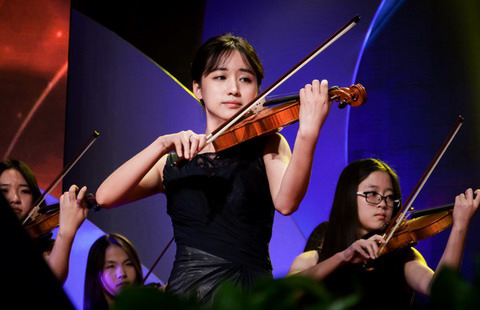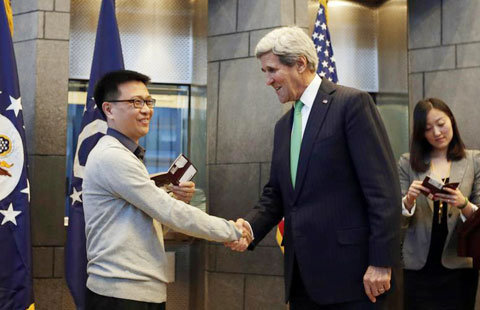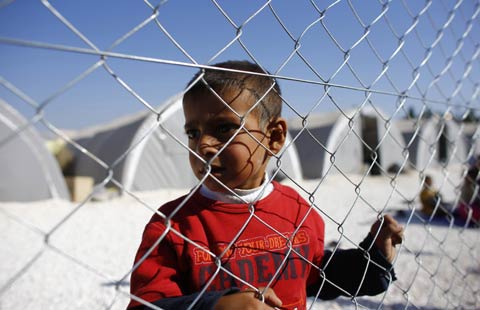
One of the most beneficial results of the 54-year-old relationship between Ghana and China has been completion of the Bui Hydroelectric Power Project, which has provided a much-needed boost of 400 megawatts to the power-starved West African nation.
Located in the Brong Ahafo region of Ghana, the project on the Black Volta River, built with the help of financing from China, has come as a relief because of the ever-increasing demand for energy in Ghana.
The construction of the Bui Dam supports Ghana's main hydropower project, the Akosombo Dam, which was built by an Italian consortium in the early 1960s.
The Bui Dam had been on the drawing board for decades. It was first visualized in 1925 by the British-Australian geologist and naturalist Albert Ernest Kitson. Various studies and plans were made over the years, but each time they were interrupted. It was not until 2007 that the government sought assistance from China to finally get the project started.
The construction was a collaboration between the government of Ghana and Sinohydro of China.
It was financed by the Export-Import Bank of China through a concessional loan of $270 million and a commercial loan of $270 million with the support of $60 million from the government of Ghana.
The addition of the dam's 400 mW of power to the generation capacity of the country has made a difference, even though the problem of finding enough power has not been solved.
Ghana has gone through turbulent energy crises that have caused both past and present governments to face the wrath of the people as the result of power rationing.
It has been so bad that a new word, dumsor, meaning "power off and on", has been added to the vocabulary of Ghanaians to describe the problem.
Ghana Energy Commission figures show before the recent completion of the Bui Hydroelectric Power Project, Ghana had a total installed capacity of 2,170 mW.
The bulk of this installed power generation, 1,180 mW, is obtained from the Akosombo and the Kpong hydroelectric power projects while other plants are powered by diesel and gas.
The Ghana Energy Commission earlier had estimated the country's energy consumption would increase to at least 2,324 mW in 2021.
The demand for energy, however, is projected to rise to 3,264 MW in 2021.
But Ghana's Deputy Ambassador to China, Alfred G. Saame, told Chinese investors in the energy sector at a recent meeting in Beijing that Ghana's policy on energy now is to achieve universal access to power by 2020.
According to Saame, the country now plans to increase its total installed electricity capacity to 5,000 mW to enable it to be energy self-sufficient by that time.
Inaugurating the Bui Hydroelectric Power Project early this year, Ghanaian President John Dramani Mahama noted: "The project comes at the time when the Ghanaian economy is growing at 7-8 percent. So the demand for energy in the country is increasing."
Ghana's quest to achieve its targeted goal of installed energy generation capacity of 5,000 mW by 2020 means that it should rely on many sources of power.
Besides the construction of the Bui Hydroelectric Power Project, China is also involved in the construction of the Ghana Gas Project to provide fuel for the generation of electricity.
Under an agreement signed in 2011, China Development Bank is providing a loan of $3 billion for a number of projects, including the Ghana Gas Project.
The project, though delayed over financing issues, is projected to be completed next year.
Some $600 million out of the $3 billion China Development Bank loan is being used to support the financing of the $850 million Ghana Gas Project.
Mahama estimates that the project will be a game changer for the economy and save $1.5 billion per year in foreign exchange and other costs.
It is expected that Ghana's Western Corridor Gas Infrastructure Development Project, with a 111-kilometer pipeline, will transport gas supplies from the Ghana Gas Project to run the Aboadze Thermal Plant.
If the gas is supplied, the expanded Aboadze Thermal Plant would be able to generate 500 mW of power using natural gas. The plant has been generating smaller amounts of electricity using oil.
That, with the addition of the 400 mW from the Bui Hydroelectric Power Project, would be a significant milestone for the country's energy future.
As a lower-middle-income country, the provision of electricity is crucial to ensure the smooth operation of the small and medium-sized enterprises that continue to spring up across the country.
China has been providing financial and technical support to help Ghana reach its goals and avoid power shortages and outages.
For China Daily
|
The Bui Hydroelectric Power Project, financed by the Export-Import Bank of China, has eased power shortages in Ghana. Lin Xiaowei / Xinhua |
(China Daily Africa Weekly 11/14/2014 page7)








